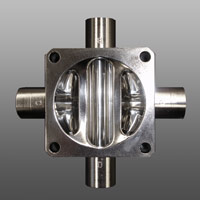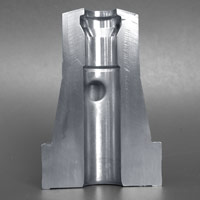An electric current and the flow of electrolytic solution create a complex removal process. The component becomes the anode, and the electrode forms the cathode of a DC current circuit. The electrode faces the surface of the component to be processed. There is a small gap between component and electrode, and the electrolytic solution flows through this gap during the ECM process. The effect of the electric current and the solution is that metal molecules are absorbed by the solution and flushed away.
The ECM deburring process is unaffected by the thickness and condition
of the burr, as well as the alloy and the construction of the component.
Cast and forged, even hardened components can be deburred reliably. Radii
and other contours can be achieved via the design of the electrode.
ECM technology can be applied for components in all conductive metals such as steel, stainless steel, aluminium, and alloys.
Advantages:

